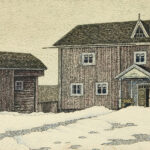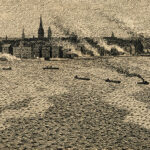Olof Thunman
Biography
Olof Thunman (1879–1944) was a Swedish painter, draftsman, and poet whose work centered on the landscapes and cultural heritage of Uppland. He studied at Stockholm’s Academy of Fine Arts from 1902 to 1906, also attending its etching school.
In 1916, he married fellow artist Carin Kuylenstierna (1879–1968). Thunman began with impressionistic landscapes, often using twilight tones, and later shifted to topographically precise drawings and washes.
In 1928, he settled in the gatehouse of Noor’s Castle in Knivsta, where he spent the rest of his life, frequently sketching the countryside on foot or by bicycle. His poetry, closely connected to the local landscape, was published in volumes such as Pan spelar (1919), Olandssånger (1927), and Fornbygd och färdvägar (1929). His best-known poem, Vi gå över daggstänkta berg (“We Walk Across Dew-Sprinkled Mountains”), is set to a melody of uncertain origin.
Thunman’s work reflects a broader Scandinavian interest in folklore, national identity, and the symbolic resonance of nature, including motifs drawn from Viking heritage. He died in October 1944.



